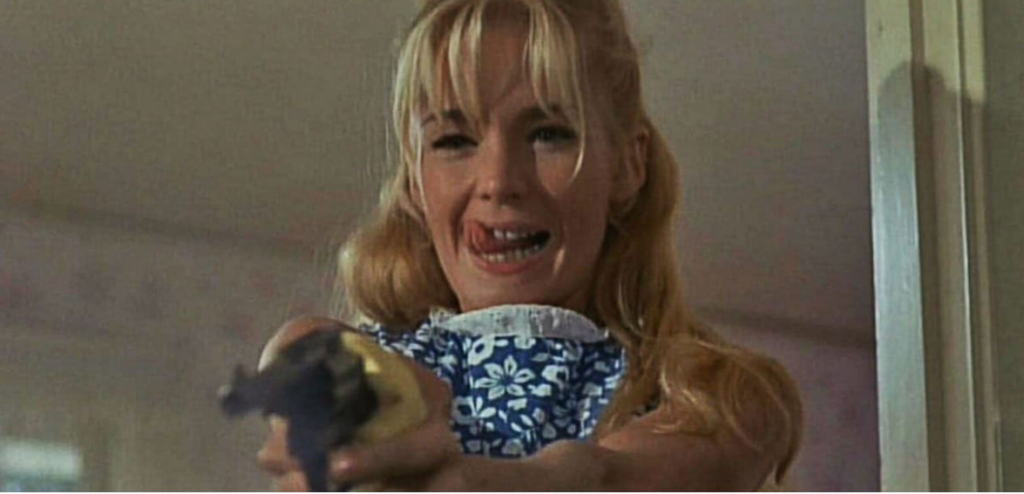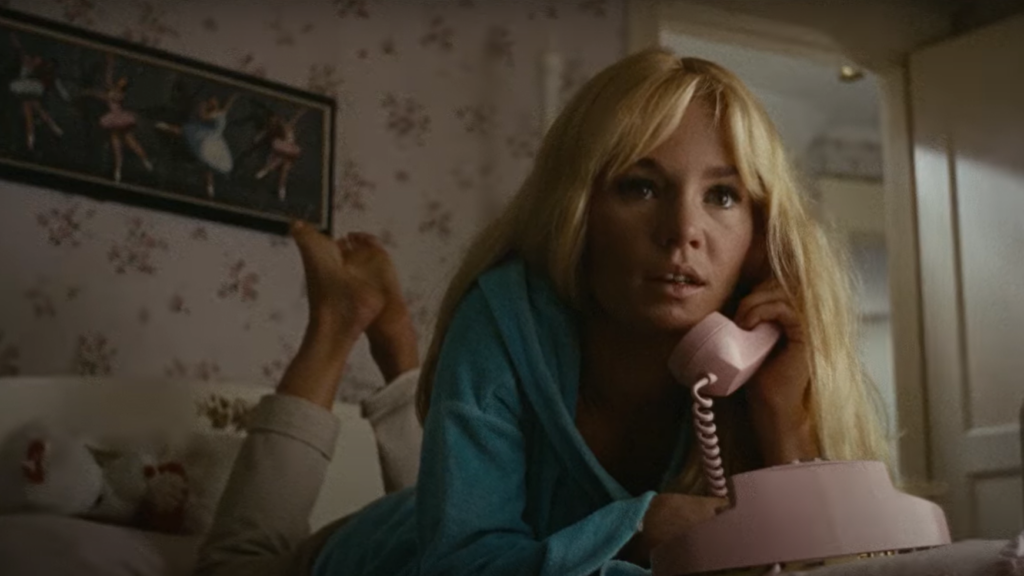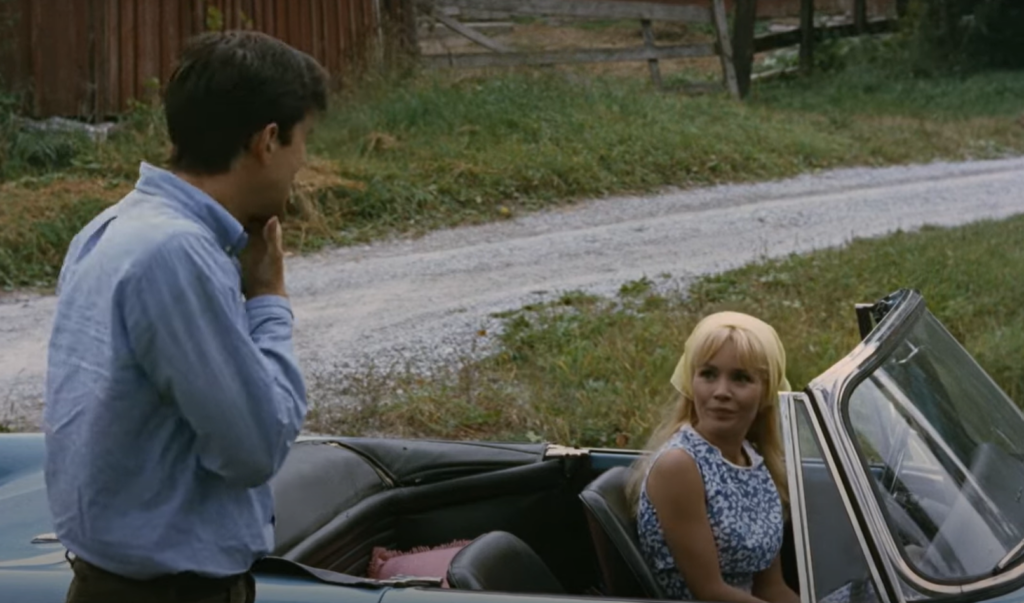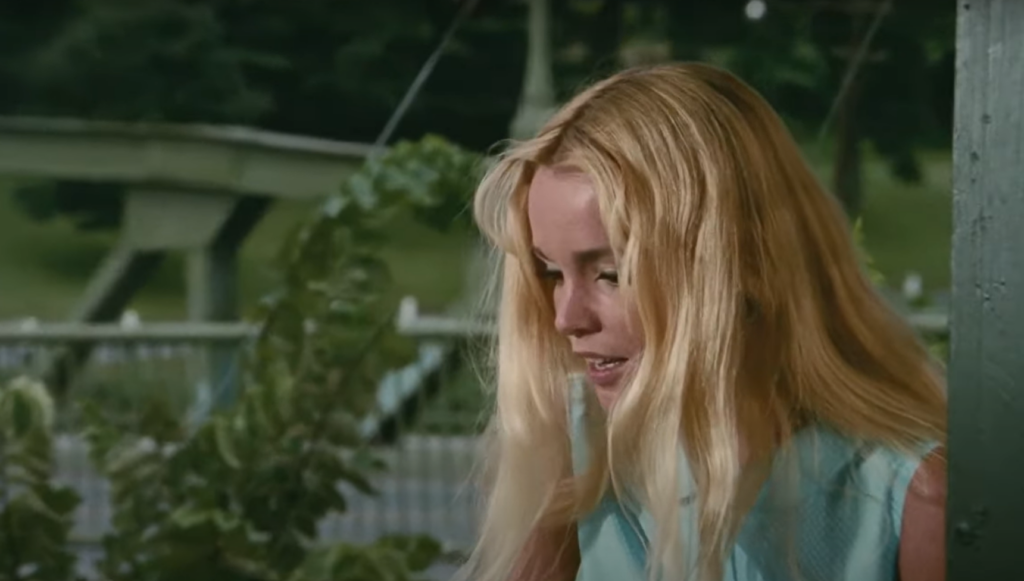| Sophie Durbin |

Pretty Poison plays at the Trylon Cinema from Friday, August 23rd, through Sunday, August 25th. Visit trylon.org for tickets and more information.
Let me set a scene for you. In a quaint little town in mid-century America, an emotionally stunted man with a suspicious past becomes fixated on a lovely young girl. In an attempt to incorporate her into an insidious plot, he whisks her away, lying about his identity and his intentions. Her mother dies and they are left with only each other. When chaos ensues, our protagonist spends the rest of his life in prison. Is this Stanley Kubrick’s 1962 adaptation of Vladimir Nabokov’s Lolita? No! It’s my deliberately misleading description of Noel Black’s Pretty Poison, a madcap adaptation of an admittedly less legendary novel called She Let Him Continue by Stephen Geller. Ladies and gentlemen of the jury, exhibit number one is what the seraphs, the misinformed, simple, noble-winged seraphs, envied.1 Today I am here to prove to you that, thanks mostly to Tuesday Weld, Pretty Poison is the perfect palate cleanser for anyone who needs a little cheering up after their biannual viewing or reading of Lolita.

As Hollywood shed the Hays Code, films were free to go anti: revisionist Westerns became the norm; antiheroes were allowed to do their thing; the seeds of neo-noir were planted. And by 1968, the year that the Code was finally abandoned, audiences were ready for an anti-Lolita. Kubrick’s film cleverly deals with the Code by hinting at the ghastlier parts of Nabokov’s novel, which requires a reader with a taste for subtext anyway. Pretty Poison was under no such obligation to subtlety. While Noel Black didn’t make the film made in direct response to Lolita, any post-1962 movie featuring a questionable age gap relationship was filmed in its shadow. The result is that Tuesday Weld gets to bounce off the walls in ways Sue Lyon would never have been able to in her charming but tragic turn as Dolores Haze six years earlier.2
Weld is staggeringly charismatic as Sue Ann Stepanek. Every question she asks is with genuine wonder. She seems to believe Tony Perkins’ insane claims of being a secret agent, but somehow never appears gullible or naïve. She’s just lucky enough to still have a brain open to the wild possibilities of life. This is an attitude that at the ripe old age of 31 I consider to be peculiar to the young. Her energy is infectious, as we see when Perkins sprints full-speed across a field after asking her out for the first time. Certainly, some of Sue Ann’s lovability can be credited to the screenplay, which gives her lines that depict the teenage brain with uncanny accuracy (“When grown-ups do it, it’s dirty…no one to punish them,” she whispers, dismayed by her mother’s sex life). This makes it even more unsettling when it’s revealed that Weld has been in control the whole time. According to her 17-year-old priorities, it’s perfectly rational to ax a night watchman in the head when he gets in her way or to casually ask Perkins to shoot her mother. And when she comes out on top at the end, it’s easy to find yourself rooting for her.

Perkins is an excellent foil for Weld—an anti-Humbert Humbert to her anti-Lolita. If we compare his performance with James Mason’s turn as the Western hemisphere’s favorite tragic pedophile, the difference is immediately clear. Mason has a layabout sophistication to him, a slow elegance to his gestures that Perkins completely inverts as he jolts his head like a comic book character and spits out his lines in staccato rhythm. His performance makes the audience question if he took the movie seriously. Was he trying to get ahead of any audiences eager to tear apart the absurdity of Pretty Poison? In my opinion, Perkins is dead serious, though larger than life. Of course, he isn’t just dealing with the specter of Mason’s Humbert Humbert. He’s carrying the weight of his own performance in 1960’s Psycho, another film that barely skated past the Code to tell its grizzly tale. As Dennis Pitt, Perkins first uses his adamant, boyish body language to play against the spooky quietude audiences associated with his depiction of Norman Bates. But in the final moments he’s resigned, his speech quiet and even, his eyes finally staying in one place. No one can do a blank stare better than Perkins! He’s bringing back Bates for a few moments of stillness and the impact is genius.

The comparison that I’m drawing here is admittedly unfair. In Lolita, Lolita can’t be called a heroine, or even an anti-heroine. She simply doesn’t have enough to do. She’s mostly a figment of Humbert Humbert’s imagination. Sue Lyon’s performance is endearingly spot-on. I think she should have had a better career, but by design she was never offered the opportunity to reach the heights that Weld is allowed to reach in Pretty Poison. The story of Lolita wouldn’t have allowed it, and neither would the Hollywood that was still determined to serve a moralistic narrative.
One of the best lines in Pretty Poison is when Dennis asks Sue Ann that question that a fool in love is bound to ask: “Why didn’t I meet you earlier in my stupid life?” As an audience member equally enthralled by Sue Ann, I may have asked the same question. I suspect the answer is simply that it took a little too long for someone as badly behaved and thrillingly alive as Sue Ann Stepanek to grace the big screen.
Footnotes
1 This whole sentence is shamelessly lifted from my tattered copy of Vladimir Nabokov’s Lolita (Vintage International Press, 1955), 9.
2 For those not in the know, Lolita’s “real” name is Dolores.
Edited by Olga Tchepikova-Treon
